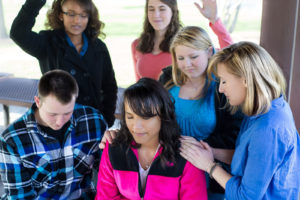It Is Important to Design Prayer Meetings with Participants in Mind
By Jonathan Graf
 A while ago, I was engaged as a consultant by a mega-church that wanted to improve as a praying church. In the course of our discussion, the senior pastor shocked me when he said, “I can’t recommend our weekly prayer meeting to many believers.”
A while ago, I was engaged as a consultant by a mega-church that wanted to improve as a praying church. In the course of our discussion, the senior pastor shocked me when he said, “I can’t recommend our weekly prayer meeting to many believers.”
Why?
About 8-10 people attended the meeting (in this church of 6,000). They were sincere people. But they were all seasoned intercessors who did not know what it meant to pray in a public gathering. They all prayed exactly as they would have in their own prayer closet. They practiced personal prayer in a group setting.
Each one who prayed, would pray for 10-20 minutes at a time, covering everything they could think to cover. And some would do so with emotion that was a little “over the top” for those around them. Tears and loud sobbing were a part of it. For the normal individual, it was downright uncomfortable.
This pastor felt—and rightly so—that the prayer meeting would set less mature pray-ers back, rather than teach and encourage them to participate.
What’s the Purpose?
Asking “What is the purpose of your prayer meeting?” may seem like a silly question. You want to seek God. You want His power, and direction, His will to be released through your prayers. You want to see your church become more dependent on Him. What do you mean, What’s the purpose of our prayer meeting?”
Recently, I participated in leading an evening of prayer at a church. It was the culminating event to a conference that had several speakers. The pastor wanted all of us—him, me and the other leader–to each feel free to step to the microphone and lead a section of the prayer time. We had a little planning for direction ahead of time, but not a lot.
The prayer meeting was fine as prayer meetings go, but something happened that got me thinking about the purpose of a prayer meeting.
At one point in the service, the microphone was opened to individuals to come up and pray. At first, instruction was given as to some general topics (schools in the area, etc.), but as was typical at prayer meetings, it become a mix of topics that were on the hearts of the pray-ers. What struck me was that the intensity of the praying increased. So much so, that soon the prayer meeting became not participatory for all, but it became a spectator event where the congregation watched as only intense intercessors prayed. After a while we got them back into groups to pray on a selected topic and the meeting was participatory for everyone again.
When I go into a church and lead a prayer meeting, I have two primary purposes in mind—and neither one has anything to do with seeking God or power, though those are important. I want to show a more dynamic way to conduct a prayer meeting, and I want to do so in a way that will draw in the weakest and most immature pray-er. I do not want to intimidate anyone.
Not all prayer meetings need to have that purpose. Mine do because of what I have been brought in to accomplish in a church when I speak there. I am trying to get the average pew sitter engaged in prayer.
My point is that a good prayer meeting leader should think about purpose when he or she plans the meeting. What do you want to accomplish with this prayer meeting? Do you want it to be accessible to all, or should it be an outlet for the strongest intercessors to go after God’s heart? If the former, then you have to watch format and passion. If the latter then you can’t worry that you only have five people coming to the prayer meeting.
If you are calling the meeting in order to “storm the gates of heaven” over a specific situation, than there is no problem with intercessors “cutting loose” and praying strong, bold, emotional, and even long prayers. But if you want to have a prayer gathering that is accessible to every maturity-level believer in your church, then it needs to be formatted in a way where even the weakest pray-er would feel comfortable there, and can see how to participate. That probably means restricting the length of individual prayers and having more prayer in smaller groups.
Many churches try to design their primary prayer meeting so it can be a place where any believer can learn, participate and experience prayer. This means you use a variety of prayer methods, not sticking to the same format week after week. (Remember people’s prayer styles?) You make sure that people understand proper protocol when praying in a group: short prayers on one topic, have a leader give the prayer subjects, break up how you pray—sometimes in small groups, sometimes as a large group. If you allow the seasoned intercessors to “cut loose” in this format, soon it will only be them praying at these gatherings.
But churches also recognize the need to have a seasoned team of prayer warriors whom it can call on to pray fervently, with no restrictions, over important issues of deep need. Kind of like a prayer swat team! There are times to free those people to pray anyway they want. But in most churches, that place is not the weekly prayer meeting that is available to all believers. There might be some times when a subject comes up at a regular all-church prayer gathering where you want these warriors to intercede. That’s okay. Let them know ahead of time if you can. But if that is not possible, in the midst of the meeting, you could say, “We need our prayer warriors freely to press in on this issue.” They will.
Even the Apostle Paul recognized different purposes for prayer and levels of intercession. In Colossians, he told the believers, “Epaphras . . . is always wrestling in prayer for you, that you may stand firm in all the will of God, mature and fully assured” (Colossians 4:12). Here, he referenced an intense level of prayer. But in writing to Timothy, he reminded him that “petitions, prayers, intercession and thanksgiving [should] be made for all people— for kings and all those in authority, that we may live peaceful and quiet lives in all godliness and holiness. This is good, and pleases God our Savior, who wants all people to be saved and to come to a knowledge of the truth” (1 Timothy 2:1-4). All levels of prayer, different types of prayer should be used in praying for the salvation of people. Different types of prayer for different purposes.
What about Multi-Church Prayer?
Understanding a prayer meetings’ purpose is also important when you try to bring churches in a community together to pray. If you have multiple theological streams of intercessors together, you should still clarify your primary purpose. If it is unity, then you want to do everything you can to assure that it is formatted to appeal to the most conservative church that was invited. Unity is more important than allowing prayer practices that might make some uncomfortable. You want to bring everyone in.
But if your purpose is something else (and it is perfectly fine to have a different purpose)–say to bring intercessors together to do spiritual warfare over your community–then you may not need to worry about making the meeting “comfortable” for every possible participant.
Don’t forget to consider these things when you plan your prayer times. Recognize that if the prayer time is geared toward one purpose, then you may not see something you want to see—more people, deeper intercession, etc. Also recognize that your prayer meeting will be more effective if you format it with a purpose in mind. Also remember that if others don’t understand or share your purpose, they can work against you. It might be important to explain your purpose with the group so they can understand what you are trying to accomplish, and what might be appropriate within that purpose.
Conclusion
While some of you may be sighing, “I just want to get people to come out to a prayer meeting. Now I have to think about purpose, too?” Don’t feel stress. It really is not that hard. If you want a gathering accessible to all believers, then a few simple principles need to be put in place.
If it is not important to accommodate the less mature pray-er, that is perfectly okay. But remember that, like my opening illustration, the gathering will eventually reflect the prayer styles of the most dominant intercessors. There is lots of value in all kinds of prayer and with all kinds of purposes. Lots of spiritual power can come out of that for your church . . . and that is good.

 –Jonathan Graf is the publisher of PrayerShop Publishing and Prayer Connect magazine and the director of the Church Prayer Leaders Network. In this capacity he regularly consults with church leadership teams on how to grow prayer in their church. He is also the author of a number of books on prayer, including Restored Power: Becoming a Praying Church One Tweak at a Time (PrayerShop 2016) from which this article was adapted.
–Jonathan Graf is the publisher of PrayerShop Publishing and Prayer Connect magazine and the director of the Church Prayer Leaders Network. In this capacity he regularly consults with church leadership teams on how to grow prayer in their church. He is also the author of a number of books on prayer, including Restored Power: Becoming a Praying Church One Tweak at a Time (PrayerShop 2016) from which this article was adapted.
Have access to many more articles on growing prayer in your church by joining the Church Prayer Leaders Network.


